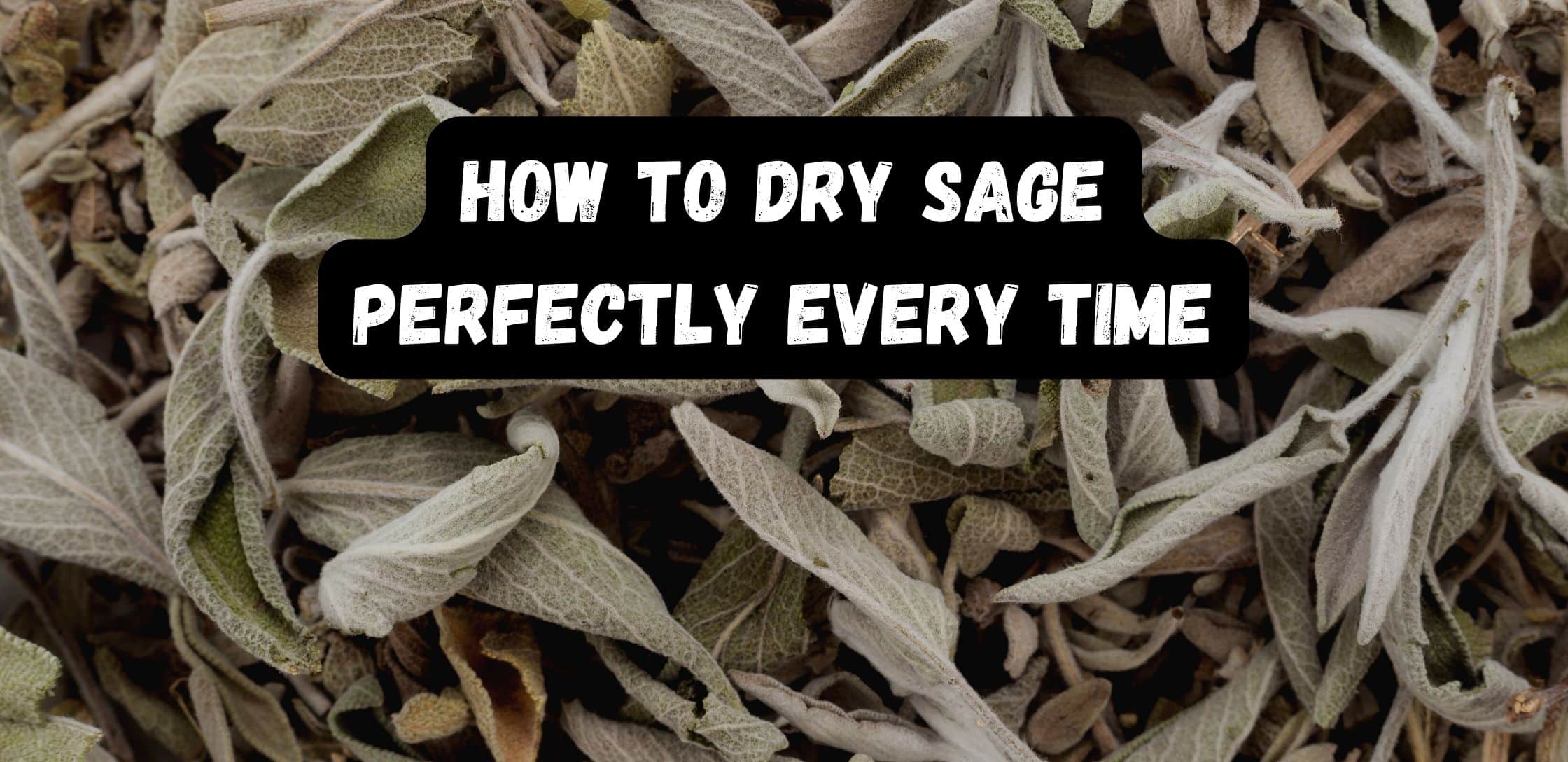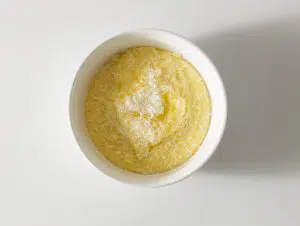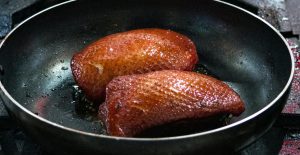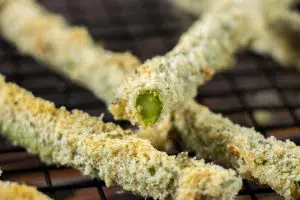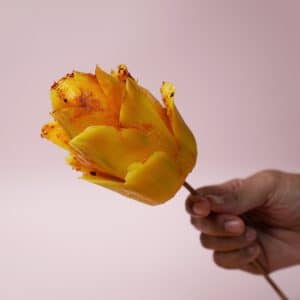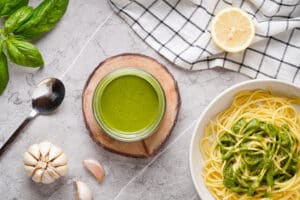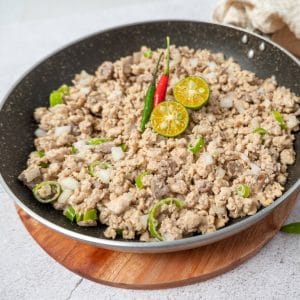How To Dry Sage – Air, Oven, Microwave & Dehydrator Covered
Important Note: When you buy through our links, we may earn a commission. As an Amazon Associate we earn from qualifying purchases. Content, pricing, offers and availability are subject to change at any time - more info.
Each year, a well-maintained, properly harvested sage plant will regrow new shoots and produce yet another season’s worth of everyone’s favorite fluffy aromatic. Sage is a sturdy herb that’s far easier to dry than delicate ones like dill or basil. It retains its wonderful flavor well, only losing a little brightness as it dries. As a pungent ingredient, many cooks find the more subtle flavor very versatile. We’ll be taking you through an in-depth look at how to dry sage, including harvesting, drying, and storage tips and practical answers to all commonly asked questions.
Table of Contents
- Key Takeaways
- Sage Drying Times
- What Is Dry Sage?
- How To Harvest And Dry Sage
- How To Dry Out Sage
- Sage Freezing
- Dried Sage Alternatives
Key Takeaways
If you have the time, air drying inside in a cool breezy area takes just under two weeks but closer to ten days and results in perfectly dried sage. Otherwise, opt for a food dehydrator that can do the job within a few hours and fruit almost the same quality sage for rubbing or crushing. Ovens dry out herbs quickly but unevenly, which negatively impacts the texture but, more importantly, adds bland bitterness and off-putting tastes from volatile oils to the flavor. Microwave drying, surprisingly, works really well in a pinch for the hasty, but we’d still stick to the natural way if you’re willing to wait and a dehydrator is out of reach.
Sage Drying Times
| Drying Device | Time | Quality |
| Natural Air Drying (Indoors) | 7-14 Days | 5/5 |
| Natural Air Drying (Outdoors) | 5-7 Days | 4/5 |
| Dehydrator | 2-5 Hours | 4/5 |
| Microwave | 2-4 Minutes | 3/5 |
| Oven | 30-60 Minutes | 1-2/5 |
What Is Dry Sage?
Dry sage is a wonderfully versatile herb that has countless culinary and household uses. All dry sage is the dehydrated, oven-dried, or naturally air-dried version of fresh sage leaves, stems, and/or flowers. With an intensified flavor and aroma, dried sage should be used sparingly or specifically when cooking. Fresh sage will never be left to go to waste once a keen cook has learned how to dry and apply it across its many uses.
How To Harvest And Dry Sage
The best time to pick sage for size and flavor is just before the plant starts blooming. Just keep the harvesting to a minimum during the plant’s first year of growth so that it can reach the strength necessary to offer sprigs and leaves for many years to come. Optimal harvesting is generally performed roughly seven to eight weeks after sprouting. Feel free to harvest a few leaves as they are needed along the way. One can even pull off the budding heads as they start to delay blossoming but performing a final harvest is essential before the sage flowers fullyfor the best flavor.
For the best health of the plant, harvest sage regularly to thin out stems. Eventually, as sage becomes denser and woodier, one should cut the thick stems, dip them in dried honey or rooting hormone, and grow clones. It is far faster and more reliable to grow a new sage plant from a healthy stem cutting than the three-week germination period faced when growing from seed.
How To Dry Out Sage
There are several different ways to dry out sage, and we’ll be detailing all of them. Each will grant dried sage of varying qualities. Portion out the quantity you think you can use up over the coming weeks to a month or two at the most, as dried sage and most other dried herbs lose most of their flavor and aroma after about six months, even with the best storage and drying conditions employed.
Whatever method you choose, there is always one of two final steps. Either rub the sage leaves gently between your fingers while catching the residue in a receptacle beneath if you want rubbed sage, or crush and powder the whole leaves while discarding the stems using a mortar or pestle, spice grinder, or a blender for ground sage. The flavor of rubbed sage is far more prominent, with fewer bitter, dank earthy undertones than ground sage. Ground sound is more neutral and has a grainy texture as opposed to rubbed sage’s soft fluffiness.
How To Dry Sage In A Dehydrator
A food dehydrator is one of the best ways to dry sage and other herbs rapidly. The dehydrator encapsulates the fresh herbs in an area that allows for quick drying, good airflow, and total protection of the plant from outside sources. One can generally expect results that are equal or superior to air drying depending on the exact drying environment being observed.
- Rinse the sage stems thoroughly and shake off all excess water.
- Preheat the dehydrator to 115°F or as close to it as possible, preferably no higher than 125°F.
- Lay out the sage evenly on the dehydrator trays without excessive overcrowding. Either lay out leaves alone if drying sage for culinary purposes or dry the whole stems when making smudge sticks.
- Allow the sage to dehydrate for two to five hours, checking the progress every thirty minutes from two hours in.
How To Dry Sage In The Microwave
The best way to dry out sage in the microwave is to place down either loose leaves or sage bundles atop a paper towel on a plate covered by another paper towel. If no paper towels are available, a glass dish covered with a damp dish towel will do. Put the power to 50% and microwave for 30 seconds before checking the progress and following with 15-second pulses until the sage is completely dried out. For cooking purposes, fresh sage typically dries in the microwave within two to four minutes at the most, whereas sage for smudging is ready in two to three.
Drying Sage In Oven
Oven drying sage is the fastest way to turn fresh herbs into their dried ground or rubbed counterpart. To dry sage in an oven, follow these steps:
- Rinse your herbs and shake off all the excess moisture
- Preheat your oven to the lowest setting possible (must be less than 180°F)
- Lay the sage out evenly without excessive overcrowding on a cookie tray lined with parchment paper or foil
- Bake the sage for 20 minutes, then open the oven and check the progress while rotating the sage to ensure even drying.
- Continue drying out the sage in the oven but with the door open while checking on it every 10 to 15 minutes until it’s dry enough to powder or crumble easily.
How To Dry Sage Leaves
The best way to dry sage for cooking is to dry the leaves independently. Pull the leaves off the stems and then opt for your preferred drying method. Drying leaves individually grants the best flavor for cooking, and air drying indoors naturally or drying sage in a dehydrator grants better results than drying sage in an oven. The only time you want stems with leaves is if you’re going to be hanging them for their scent or burning them as a part of a smudge stick.
How To Dry Sage Bundles
Sage bundles are conventionally tied together by the stems and then suspended upside down indoors in an area with good air circulation. I Make a bundle out of five stems and tie the ends together with cotton string, twine, or any other suitable fastener like a rubber band or flexible thin piece of wire if you’re not planning to dry them in an oven or microwave, of course.
It is best to dry sage bundles suspended upside down in a dehydrator or in open air within a paper bag. This creates the ideal humidity for even drying, it protects the sage from insects and other contaminants, and the bag catches dried sage leaves as they grow brittle and fall off. Otherwise, dry out your sage in the microwave or use an oven.
How To Make Dried Sage Bundle
To make a sage bundle, start by laying down a stem or two of dried sage with all of its leaves. If combining dried herbs. lay a sprig of lavender or any other aromatic preferred atop the sage, and then place another sprig of sage on top of this. Follow with any other herbs preferred, such as rosemary but don’t make the bundle too thick. Trim the stems as close to the last leaves as possible. Use a thin cotton string or hemp twine to bind the dried sage bundle together, starting at the bottom while winding your way to the top and then working it back to the base.
How To Store Dried Sage
Unless you’re totally opposed to the task of crushing before a meal, dried sage should always be stored whole. Only crush leaves immediately before use as from the moment herbs are dried, they begin degrading, and the degradation hastens significantly once crushed or rubbed to powder. Regardless of which form you decide to store it in, crushed, rubbed, or whole leaves, always keep the dried sage in an airtight container, preferably one that doesn’t allow direct sunlight through. Keep this in a cool, dark cupboard, and your sage will stay fresh for three months before starting to lose aromatics and flavor significantly.
Sage Uses In Cooking
Dried sage has a span of different culinary uses. From meals that focus on sage as the base flavor to enhancing the taste of other food with something as simple and subtle as a sage cream sauce, there are tons of ways to use both the ground and rubbed version of this herb. Here are the best sage uses in cooking.
Pair It With Fatty Meats To Help Digestion
As a carminative compound and antispasmodic, sage supports healthy digestion while hindering gas from forming. As a result, it’s a great herb to combine with fatty food to help it digest easier. Fortunately, the taste of sage goes particularly well with hearty, comfort food and rich, savory tastes – there’s often no better pairing for the palette and gut.
Add Herbaceousness To Sauces, Stews & Soups
Any meal that has an element of richness pairs well with the bold, earthy herbaceousness of sage. Add it to stews and soups of all types, and don’t forget to experiment with combinations involving other woody herbs like thyme. A simple sage sauce brings together otherwise flat flavors wonderfully, so be sure to try it with creamy sauces as well.
Put Together The Perfect Stuffing
Poultry stuffing simply wouldn’t be the same without sage. Most prefer rubbed, but ground is just as effective for an even more intense flavor spectrum. A basic but delicious turkey stuffing contains nothing more than two teaspoons of dried sage (or a teaspoon of fresh), a teaspoon of thyme, two minced celery stalks, minced garlic, diced onion, toasted seasoned cornbread or sourdough bits, ground black pepper, and a beaten egg. For those who enjoy stuffing, our turkey stuffing meatballs are to die for, and they follow this basic recipe. While contemplating stuffing, fruit stuffing with sage is another must-try for anyone with a sweet tooth.
Blend Together A Rub Or Marinade
Include rubbed or crushed sage in a tasty rub containing equal or varying quantities of other herbs like marjoram, oregano, rosemary, fennel, black peppercorns, chili flakes, sugar, and salt. Just about any other combination of herbs preferred works, and be sure to double up and add oil and a source of acidity if you’re making a marinade.
Combine A Sage Compound Butter
Flavored butter can involve almost any combination of herbs and spices, but sage butter is a heavenly incarnation that is considered divine by many when combined with roasted garlic as well. Compound butter is a must-try.
Sage Freezing
Frozen sage lasts for three to four months while still retaining its integrity. Use freezing to preserve fresh sage for those times when you want the flavor to be extra strong. All you need to do is slip a few leaves into each cube of an ice tray filled with water and let it ice up. Freezing sage concentrates the flavor, so keep this in mind, as you’ll only need a little over half the quantity to get the same taste as when using freshly picked sage. Don’t expect to dry sage out once it has been frozen, as this will be very tricky.
Dried Sage Alternatives
Fresh sage is almost always preferred over any dried variety. However, if fresh, rubbed sage ground sage is not available, then opt for another woody, strong herb. The best alternative to sage is typically marjoram which has a similarly pungent pine-like flavor profile. Rosemary and thyme are generally the next best, followed by oregano, savory, tarragon, or bay leaf. Those who are all out of fresh herbs but have any sort of premixed poultry seasoning on hand should consider using it as a substitute, as most seasoning blends for chicken and turkey contain sage.
Drying Sage – Frequently Asked Questions
There’ll be no question left unanswered once you’ve gone through our selection of frequently asked questions about drying sage.
How To Make Sage Tea?
To make sage tea, steep one tablespoon of dried sage in a cup of very hot but not yet boiling water. Give it around five minutes of steeping, but no more than ten, or the flavor will lose its taste and gain intense bitterness. Strain the sage out and serve black with or without sugar or an alternative sweetener. Try blending sage and lavender or sage and either lemon or orange juice for a spin on classic sage tea that’ll have you coming back for more. It’s particularly addictive with citrus and an added hint of ginger.
How Much Sage Is Too Much?
The right quantity of sage could be a minuscule amount depending on your desired outcome and the serving size. It takes an extended period of cooking to bring out the flavor of sage, so don’t misjudge a lack of initial flavor in a meal and add too much. Most meals take nothing more than half a tablespoon of rubbed or ground sage when sage is a core flavor. When cooking for four to five people, a stew or casserole will typically only include one tablespoon of dry sage, whereas a rub or marinade may contain more. Anything more than two to three tablespoons when cooking for a huge number of guests tethering around eight to twelve is too much.
How Long To Dry Sage For Smudging?
Sage for smudging should be dried to the point where the plant is dehydrated but still flexible enough to be handled, bent, and bound with twine or cotton without crumbling to powder at a touch. That means that sage is typically dry enough after three to four days of air drying, although it can take up to a week. When drying in a food dehydrator, you’re looking at two to three hours. In an oven, thirty to forty minutes is the most that fresh sage typically needs to be the right consistency for use in a smudge stick.
How To Make Sage Spray With Dried Sage?
Infusing home-grown herbs like sage into water to use as a misting spray is a wonderful way of freshening up the feel of any space. Those who put smudge sticks to active use often call this water-based sage infusion a smudge or aura cleansing spray, believed to clear the energy of an area. No matter how you see it, the scent is wonderfully grounding and readily instills a welcoming sense of calm when used sparingly in any room. Furthermore, it effectively repels bugs which is great for cupboards and general storage.
Making sage spray is almost as simple as making sage tea. Here are the six basic steps to follow to have your own sage spritzer liquid in no time:
- Bring a kettle of water towards boiling point and stop it as soon as you hear the rapid bubbling sound rolling (the ideal temperature is between 208 – 212°F or at 194°F, to be exact).
- Measure out six tablespoons of ground sage or eight tablespoons of rubbed and add it to half a cup of hot water from the kettle.
- Mix in half a cup of white vinegar.
- Stir in and completely dissolve a teaspoon of coarse salt.
- Cover and allow the solution to steep for twelve to twenty-four hours in a dark, cool place.
- Strain and dispense into a spritzer.
If this isn’t how to make sage spray with dried sage as you’d prefer it, opt for a mixture that uses sage essential oil blended with water instead. Either make your own by extracting oil from fresh or dried sage using Everclear, rubbing alcohol, or a strong white spirit like vodka, or shop around for a high-quality store-bought extract if you’re looking for extreme convenience. It is often a good idea to blend sage water (made by any method) with essential oils like lavender, Clary sage, lemon, and/or ylang ylang to create a refreshing mist.
How Long Does It Take To Dry Sage?
Air drying sage takes seven to ten days but can take up to two weeks. Drying sage in a food dehydrator usually takes around three to four hours. Sage should dry slowly in an oven at low heat, and is ready within an hour, so check every fifteen minutes. Microwave dried sage is dry and crumbly within two to four minutes, with the average microwave taking around two and a half.
How Much Dried Sage Equals Fresh?
One tablespoon of ground sage is equivalent to one teaspoon of chopped fresh sage. Rubbed sage has a purer sage flavor but isn’t so intense, so you’ll need roughly one and a half teaspoons for the equivalent of a teaspoon of fresh herb.
How To Dry Sage For Smudge Sticks?
The best way to dry sage for smudge sticks is bound together in a bundle of five to six stems with their leaves. Air drying for three days to a week is how most make their smudge sticks, but drying in a good dehydrator is far quicker and grants an almost indistinguishable end product. A bundle of sage is typically dry enough for smudging within two to three hours at 115°F in a dehydrator, two to three minutes in the microwave, or half an hour so in an oven on its lowest heat. If oven or microwave drying, dry the stems individually before combining and wrapping them into a single solid stick.
Does Dried Sage Go Bad?
Within around six months, dried sage loses almost all its flavor and aroma compounds. Any much longer, and the sage will be so degraded that using it in food would be akin to adding bitter bland crushed leaves without any other taste at all. Sage never technically goes bad unless there’s external contamination and/or poor storage conditions, but it becomes tasteless very quickly.
How To Dry Sage Flowers?
Sage flowers can be air-dried, dehydrated, or oven-dried in the same manner as sage leaves or stems with the leaves attached. The longest one will generally have to wait for flowers to air dry to a crumbly consistency is around one to two weeks.
Are All Varieties Of Sage Edible?
There are more than seven hundred and fifty different types of sage, but not all of them are edible. Many cultivars are purely ornamental and carry nothing more than a misleadingly similar smell but very little flavor at all, rather tasting bitter and sharply strange. Stick to common/garden sage (Salvia officinalis) or confirm edibility and the flavor to be expected before procuring or growing anything else.
